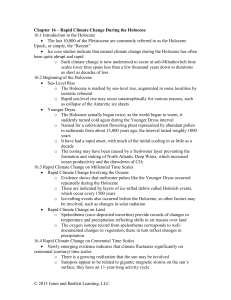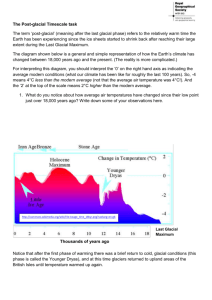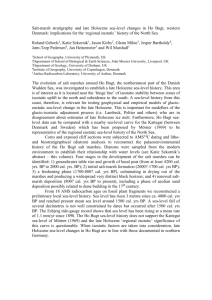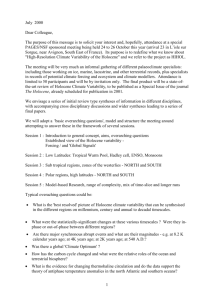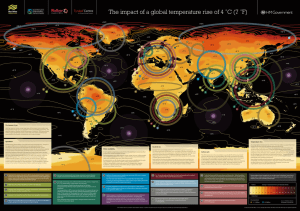The southern North Sea? Rhine-Thames ...
advertisement
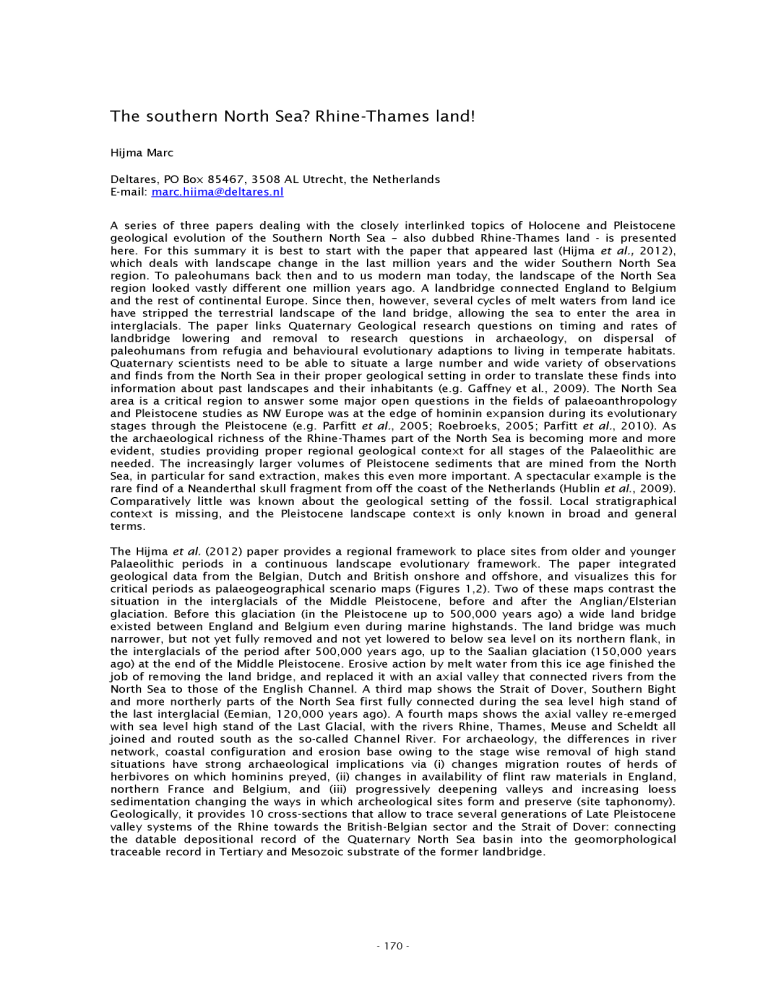
The southern North Sea? Rhine-Thames land! Hijma Mare Deltares, PO Box 85467, 3508 AL Utrecht, the Netherlands E-mail: m arc.hiim a@ deltares.nl A series o f three papers dealing w ith the closely interlinked topics o f Holocene and Pleistocene geological evolution o f the Southern North Sea - also dubbed Rhine-Thames land - is presented here. For th is sum m ary it is best to start w ith the paper th a t appeared last (Hijm a e t a i, 2012), which deals w ith landscape change in the last m illion years and the w ider Southern North Sea region. To paleohum ans back then and to us modern man today, the landscape o f the North Sea region looked vastly d iffe re n t one m illion years ago. A landbridge connected England to Belgium and the rest o f continental Europe. Since then, however, several cycles o f m elt waters from land ice have stripped the te rre stria l landscape o f the land bridge, allow ing the sea to enter the area in interglacials. The paper links Q uaternary Geological research questions on tim in g and rates o f landbridge low ering and removal to research questions in archaeology, on dispersal o f paleohum ans fro m refugia and behavioural e volutionary adaptions to living in tem perate habitats. Q uaternary scientists need to be able to situate a large num ber and wide variety o f observations and fin d s fro m the North Sea in th e ir proper geological setting in ord er to translate these fin d s into inform a tion about past landscapes and th e ir inhabitants (e.g. Gaffney et al., 2009). The North Sea area is a critical region to answer some m ajor open questions in the fields o f palaeoanthropology and Pleistocene studies as NW Europe was at the edge o f hom inin expansion durin g its evolutionary stages th ro ug h the Pleistocene (e.g. Parfitt e t a!., 2005; Roebroeks, 2005; Parfitt et a!., 2010). As the archaeological richness o f the Rhine-Thames part o f the North Sea is becoming more and more evident, studies providing proper regional geological co nte xt fo r all stages o f the Palaeolithic are needed. The increasingly larger volum es o f Pleistocene sedim ents th a t are mined from the North Sea, in particular fo r sand extra ction , makes this even more im p orta nt. A spectacular exam ple is the rare fin d o f a Neanderthal skull fra g m e n t fro m o ff the coast o f the Netherlands (Hublin e ta !., 2009). C om paratively little was known about the geological setting o f the fossil. Local stratigraphical co nte xt is m issing, and the Pleistocene landscape co nte xt is o nly known in broad and general term s. The Hijma e t al. (2012) paper provides a regional fram ew ork to place sites from older and younger Palaeolithic periods in a continuous landscape e volutionary fram ew ork. The paper integrated geological data fro m the Belgian, Dutch and British onshore and offshore, and visualizes th is fo r critical periods as palaeogeographical scenario maps (Figures 1,2). Two o f these maps contrast the situation in the interglacials o f the Middle Pleistocene, before and after the A nglian/E lsterian glaciation. Before th is glaciation (in the Pleistocene up to 500,000 years ago) a wide land bridge existed between England and Belgium even during marine highstands. The land bridge was much narrower, but not yet fu lly removed and not yet lowered to below sea level on its northern flank, in the interglacials o f the period a fte r 500,000 years ago, up to the Saalian glaciation (150,000 years ago) at the end o f the M iddle Pleistocene. Erosive action by m elt w ater from th is ice age finished the jo b o f rem oving the land bridge, and replaced it w ith an axial valley th a t connected rivers from the North Sea to those o f the English Channel. A th ird map shows the Strait o f Dover, Southern Bight and more n orthe rly parts o f the North Sea firs t fu lly connected durin g the sea level high stand o f the last interglacial (Eemian, 120,000 years ago). A fo u rth maps shows the axial valley re-emerged w ith sea level high stand o f the Last Glacial, w ith the rivers Rhine, Thames, Meuse and Scheldt all jo in e d and routed south as the so-called Channel River. For archaeology, the differences in river network, coastal co nfig uratio n and erosion base owing to the stage wise removal o f high stand situations have strong archaeological im plications via (i) changes m igration routes o f herds o f herbivores on which hom inins preyed, (ii) changes in availab ility o f flin t raw m aterials in England, northern France and Belgium, and (iii) progressively deepening valleys and increasing loess sedim entation changing the ways in which archeological sites fo rm and preserve (site taphonom y). Geologically, it provides 10 cross-sections th a t allow to trace several generations o f Late Pleistocene valley systems o f the Rhine tow ards the British-Belgian sector and the Strait o f Dover: connecting the datable d epositional record o f the Q uaternary North Sea basin into the geom orphological traceable record in T ertia ry and Mesozoic substrate o f the fo rm e r landbridge. - 170 - = - 1 ,000,000 - 500,000 yr ago = Bavelian, Cromerian Complex = MIS 21, 19, 17, 15, 13 highstands E A R L Y M ID D L E P L E IS T O C E N E ( p a la e o g e o g r a p h ic s c e n a rio ) F igure 1. A n in te rg la c ia l h ig h s ta n d s itu a tio n d u rin g th e e a rly M id d le P le istocene as re p e a te d ly o c c u rrin g b e tw e e n 1 and 0 .5 Ma (i.e. ‘ Bavelian, C ro m e ria n C o m p le x '; MIS 21, 19, 17, 15, 13) sh o w in g highstand: shallow sea lowstand: delta of Rhine-Meuse-Thames re p e a te d ly g la c ia te d he a dlan d s. SOUTHERN NORTH SEA Holocene drow ning o f the North Sea The largest river in the southern North Sea is the Rhine-Meuse system. The paper by Hijma V.u ’ h f- r n North coastal plain and Cohen (2011) describes the tran sition from Late Pleistocene valley to Holocene delta plain o f th is system, onshore and offshore o f the present coast. The critical period in this tra n sitio n was the tim e between 9000 and 6000 years ago. A series o f palaeogeographical maps is presented, based on w e a ld m apping and dating at very high data densities and com pletely covering the system - reaching a level o f detail unsurpassed in the H /.r.'T i w orld. The map series shows a Rhine-MeusePalaeogeography at times of high sea level Scheldt estuary offshore o f Rotterdam at Uplands, valleys, coastsand shallowseas Resistant strata Rivers and structural _geomorphology .. . I I Shalow sea and coast I I ancient terraces I 1 Palaeocene marine clay / " * ■ Evident from deposits, geomorphology 9000 years, which rapidly drowns and shifts ■ ■ Active floodplainsand deltas I I Higher uplands I-1-!! Cretaceous chalk . Inferred river courses Relative young terraces 0 Early palaeolithic sites Palaeozoic outcrop * \ v # Cuestas, major faults, basin hinge line landwards, loses the Scheldt as a feeding river, starts to lose the Rhine too, develops a m uddy and organic backfill and em bryonic barrier systems, e xpo rts sedim ent to the coastal barrier system and tid al inlets to the north o f the drow ning estuary. A ll o f th is happens over a tim e period o f 2500 years, leading up to stabilisation o f barrier coastal system around 6000 years ago. This resolves the transgressive stage o f coastal evolution o f the North Sea to sim ilar level o f detail and process explanation as the later Holocene stages. To have closed th is fo rm e r knowledge gap is especially im p o rta n t because it allows studying landscape evolution o f the North Sea’s river valleys from the last ice age to its river m ouths and coasts o f the Holocene in a continuum . -".M, . - S y fW n lE r c The position o f the Rhine-Meuse-Scheldt system on the wide, low -gradient continental shelf th a t the North Sea basin provides is o f particular im portance. It has made th a t base-level changes is a d om in a nt control on sedim entation fo r relative short periods o f tim e w ith in glacial cycles only, and kicks in relative late in the interglacial. Plenty o f accom m odation space is left to fill by te rre stria l deposition by rivers, and the system can be seen to go th ro ug h changes in sedim entary style in response to hinterland clim atic changes. This holds fo r fu ll glacial co nd itio ns o f the Last Glacial M axim um and tim es before; w ith beginning w arm ing in the Late-glacial, and w ith continued w arm ing o f the Early Holocene, and the later North Sea flo o r and coastal plain base overly considerable preserved valley surface area from each o f these tim e periods. IL A P IL F OU f'Fb N ^ TI F AT I F b K b I'^ lb TI U N Fb -. IL A Ao L il.L A A PUIA A IL ( p a la e o g e o g ra p h ic s c e n a rio ) = '80-000 * 20,000 yrEar1y ago and = last glacialpieniglacial until LGM = Weichse|ian: Midd|e = m is 4 -3 -2 lowstand L ATE P L E IS T O C E N E : F IR S T 5 0,000 Y E A R S = Eem’ ) ( p a la eogeogra phic scenario ) = MIS 5e highstand; MIS 5d-a falling stage = Last Interglacial and begin Last Glacial SOUTHERN NORTH SEA Saalian Drenthe SOUTHERN NORTHSEA E a s t A n g lia E a s t A n g lia / ' B ank'S ,, delta plain B ro w n J B a n k " -.,! since -6 0 ka Rhine-Meuse Thames ____ W e a ld W eald :dover STRAIT A rto is L-A rtois Channel river A rd e n n e s A rd e n n e s | Eemian highstand □ Shallowsea andcoast ■ Rrvervalleys4 deltas PM Uplands (higher, lower) Last Glacial Rhine-Thames-Channel river and surroundings Resistant strata Rivers and structural geomorphology [T~] Last-active braidplams |-----1Uplands p q Palaeocene marine day/— Evident fromdeposits, geomorphology q pieniglacial terraces, with site r j Brief ice sheet presence E 3 Cretaceous chalk / - Possible additional temporarypaths Emerged seafloor and □ Brief blocked drainage m Palaeozoc outcrop * \*. Cuestas, may* faulls. basin hinge line formervalleys(higher, lower) Early Weichselianfalling stage Resistant strata Rivers and structural geomorphology □ Shallowsea andcoast B Palaeocene marine d a y /- Evident fromdeposits, geomorphology H J Activeriver deltas E 3 Cretaceouschalk Inferred continuations I delta dnrenuons I 1 submerged/emergingvalley Palaeozoic outcrop \V»» cueslas' major faulls. basin hingeline F igu re 2. Le ft: T he h ig h s ta n d s itu a tio n o f th e Last In te rg la c ia l (MIS 5e) and th e fa llin g sta g e (sub-) h ig h s ta n d s o f th e Early W e ich se lia n (MIS 5d-a). T h e m ap is re p re s e n ta tiv e f o r th e la te M id d le P a la e o lith ic (1 3 0 -8 0 ka ago). R ight: T he lo w s ta n d s itu a tio n fo r th e c o ld e s t p a rt o f th e Late P leistocene, th e W e ich se lia n Early and M id d le P ie n ig la cia l, up to th e Last G lacial M a x im u m (_ 8 0 -2 0 ka ago). - 171 - For the transgression, it is shown th a t the base o f the coastal prism records three stages, (i) From the m illennium before 8.45 ka BP, deltaic flu via l environm ents o f extensive wetlands bury Lateglacial and Early Holocene valley parts, (ii) The m illennium a fte r 8.45 ka begins w ith a rapid drow ning event. Thereafter, marked erosion in the coastal zone, an em bryonic barrier system th a t stepped back many kilom eters, increasing tid al am plitudes in the estuaries, and bay-head delta developm ent in upper estuarine environm ents are seen, (iii) The period between 7.5 and 6.3 ka BP saw the Rhine step backward and d ivert away from th is fo rm e r m outh th ro u g h m ultiple avulsion, and eventually saw the coastal barrier system stabilize its position, m arking the high stand to have commenced. Sea level ju m p in g 8,450 years ago The paper by Hijma and Cohen (2010) describes the evidence fo r the pulse o f accelerated sea-level rise th a t occurred at 8.45 ka. Both the tim in g and the m agnitude o f th is sea-level ju m p were q uantified d irectly fro m precise sea-level data harvested from the Rhine delta. Evidence fro m te rrestrial, glacial, and global clim ate m odel reconstructions suggests th a t th is sea-level ju m p was caused by huge am ounts o f m eltw ater release in the fin al stages o f existence o f proglacial lake Agassiz in North-Am erica. Drainage o f th is lake in fro n t o f the m elting Laurentide ice sheet is nowadays w idely regarded to have caused the 8.2 ka cooling event, th a t was particularly significant in the N orthern Hemisphere (see T örn qvist en Hijma, 201 2 fo r a recent overview). The chronology o f the m eltw ater pulse, however, so fa r had been based on marine data o f lim ited dating accuracy, which had placed it at ca. 8470 ± 300 yr. The data fro m Rotterdam, observed at considerable distance fro m the release site, specify a bru p t sea-level rise to have comm enced 8450 ± 44 yr ago and shows sea level markers fro m before and a fte r the ju m p to be separated 4 meters vertically. Between 8500 to 8300 years ago, sea level is shown to have ju m p e d a 2.11 ± 0.89 m, in a dd itio n to background relative sea-level rise over th a t tw o century period (1.95 ± 0.74 m). In o the r words: in the North Sea basin, in these special centuries sea level rise was double th a t o f w hat was seen in the centuries before and after. Considerable areas o f land transform ed to shallow sea at th is tim e. Full marine connection between the Southern Bight and German Bight was established, and the wave and tid al regime as we know it to da y spun up. The tem poral acceleration o f the sea-level ju m p catalyzed these tran sfo rm atio n s from subaerial to drowned conditions. The event set back coast lines and river m ouths, and is recorded as the transgressive surface at the base o f the Rhine-Meuse coastal prism . Due to the event-nature o f the sea level ju m p , the dia chro ne ity o f th is transgressive surface is stron gly suppressed in the critical area o f the later coastal zone. The fo u r meters o f very rapid rise were follow ed by some 10 meters o f gradually decelerating fu rth e r rise in the m illen n ia which drowned the basal transgressive contact relatively deep, preserving it relative widely. Corrected fo r g ravitational effects w ith distance to release site, the m agnitude at Rotterdam translates to a global-averaged eustatic sea-level ju m p th a t is double the size o f previous estim ates (3.0 ± 1.2 m versus 0 .4 -1 .4 m). The discrepancy suggests e ither a coeval A n ta rctic c o n trib u tio n or, more likely, a previous underestim ate o f the to ta l Am erican lake drainage. Besides the global clim atological and sea level signal links, the event is o f circum -oceanic stratigraphical relevance deltaic and coastal successions w orldw ide, event to the e xten t th a t ju m p ’s transgressive contact is o f use in fo rm a lly d ivid in g the Early Holocene from the Middle Holocene (Hijm a en Cohen, 2010; Cohen en Hijma, 201 3). Reference to the sea-level acceleration results since 2010 includes the IPCC fifth assessment report, prospection and discovery o f Early M esolithic sites below Rotterdam harbour extension (Weerts et al., 2012), and renewed atte ntio n to the tim e-depth interval in Asian deltas, notably th a t o f the Yangtze (Wang et al., 201 3). C ontinuous geological coverage The series o f papers address critical tim e-periods th a t to g e th e r describe the com ing into existence o f the North Sea as we know it today. This provide a considerably updated fram ew ork fo r the m acro-evolution o f the North Sea during the last m illion years. In our appreciation, o ld er macroevolutionary overviews in the past often suffered from gaps. Late Pleistocene chapters w ould cover the glacial m axim um pre do m in an tly and Holocene chapters the last 6000 years. Early Holocene te rre stria l co nditions were not considered to be relevant fo r sedim entation. Understanding o f the Holocene transgression o f the North Sea was underdeveloped and projection rather than based on mapping. The papers avoid such gaps. Clouds o f sea-level rise data were collected from before, from durin g and from after the sea-level ju m p in the 2010 paper. The fu ll tra n sitio n from glacial river valley, th ro u g h adaptive phases o f clim atic am elioration o f the glacial-interglacial tran sition , th ro ug h transgressive estuarine situations, to the eventual barrier coast and delta plain is described as a continuous sto ry in the 2011 paper, h ig h lig h tin g aspects o f geological-geom orphological inheritance in the developm ent besides external changes. The progressive nature o f the erosive tran sfo rm atio n o f the Belgian-English landscape to the Southern Bight open sea is h ighlighted in the 201 2 paper. - 172 - Such e ffo rts enable next steps o f research, such as studying rates o f coastal processes under considerable sea-level rise (e.g. fo r coastal geom orphologists), regional geological correlation and com parison along the North Sea (e.g. fo r stratigraphers), and the m erging o f te rre stria l and offshore geological fram ew orks (e.g. fo r p aleolithic archeologists). Furtherm ore, the publications have renewed international atte ntio n fo r the Southern North Sea region as a geological reference area fo r shelf, delta and sea-level research. Lastly, the papers contain new insights th a t are provoking and renewing research cooperation between onshore and offshore groups from the countries around the North Sea. Research group acknowledgm ents The papers fro m 2010 were part o f the Ph.D.-research o f the main applicant between 2005-2009 at Utrecht U niversity (The Netherlands). The w ork was done in close cooperation w ith Dr. Kim Cohen (Utrecht University; Deltares and TNO Geological Survey o f The Netherlands). The 2012 paper is the outcom e o f a post-doctoral stay at Leiden U niversity w ith professor Wil Roebroeks, w ith Dr. Wim W esterhoff and Dr. Freek Busschers (TNO Geological Survey o f The Netherlands) as fu rth e r collaborators. References Cohen K.M. and M.P. Hijma, 201 3. The transgressive Early-Middle Holocene boundary - the case fo r a GSSP at Rotterdam, Rhine Delta, N orth Sea Basin, STRATI 2013 1st International Congres on Stratigraphy, Lisboa: Ciencias da Terra Universidade Nova de Lisboa: 148-49. Gaffney V., S. Fitch and D. Smith. 2009. Europe's lost w orld: the rediscovery o f Doggerland. Council fo r British Archeology, York. Hijma M.P. and K.M. Cohen. 2010.Tim in g and m agnitude o f the sea-level ju m p preluding the 8200 yr event. Geology 38(3):275-278. Hijma M.P. and K.M. Cohen. 2011. Holocene transgression o f the Rhine river m outh area, The N etherlands/Southern North Sea: palaeogeography and sequence stratigraphy. Sedim entology 58 (6): 1453-1 485. Hijma M.P., K.M. Cohen, W. Roebroeks, W.E. W esterhoff and F.S. Busschers. 201 2. Pleistocene RhineThames landscapes: geological background fo r hom inin occupation o f the southern North Sea region. Journal o f Q uaternary Science 27(1 ): 1 7-39. Hublin J.J., D. Weston, P. Gunz, M. Richards, W. Roebroeks, J. Glimmerveen and L. A nthonis. 2009. Out o f the North Sea: the Zeeland Ridges Neandertal. Journal o f human evolution 57(6):777785. Parfitt S.A., N.M. A shton, S.G. Lewis, R.L. Abei, G.R. Coope, M.H. Field, R. Gale, P.G. Hoare, N.R. Larkin, M.D. Lewis, V. Karloukovski, B.A. Maher, S.M. Peglar, R.C. Preece, J.E. W hittaker and C.B. Stringer. 2010. Early Pleistocene human occupation at the edge o f the boreal zone in northw est Europe. Nature 466(7303):229-233. Parfitt S.A., R.W. Barendregt, M. Breda, I. Candy, M.J. Collins, G.R. Coope, P. D urbidge, M.H. Field, J.R. Lee, A.M. Lister, R. Mutch, K.E.H. Penkman, R.C. Preece, J. Rose, C.B. Stringer, R. Symmons, J.E. W hittaker, J.J. Wymer and A.J. Stuart. 2005. The earliest record o f human activity in northern Europe. Nature 438 (7070): 1008-101 2. Roebroeks W. 2005. Life on the Costa del Cromer. Nature 438(7070):921 -922. T örn qvist T.E. and M.P. Hijma. 201 2. Links between early Holocene ice-sheet decay, sea-level rise and abrup t clim ate change. Nature Geoscience 5:601-606. Wang Z., Q. Zhan, H. Long, Y. Saito, X. Gao, X. Wu, L. Li and Y. Zhao. 201 3. Early to m id-Holocene rapid sea-level rise and coastal response on the southern Yangtze delta plain, China. Journal o f Q uaternary Science 28:659-672. Weerts H., A. Otte, B. Smit, P. Vos, D. Schiltmans, W. Waldus and W. Borst. 2012. Finding the Needle in the Haystack by Using Knowledge o f M esolithic Human A daptation in a D rowning Delta. Journal fo r A ncient studies Special volum e 3:1 7-24. - 173 -
